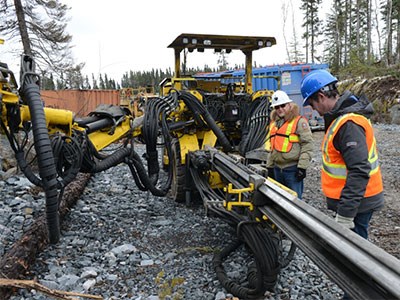Stephen Roman needs no reminder that Ontario is lagging behind the rest of Canada in wait times for approval of mining exploration permits.
“The permitting process is very slow, very cumbersome and you need a lot of money,” states the chairman and president-CEO of Harte Gold, a junior miner that’s advancing its Sugar Zone deposit in the Hemlo gold fields toward commercial production this year.
Roman was responding to a report by the Fraser Institute which labelled Ontario a “laggard” for the time it takes to approve mining exploration permits.
The think-tank’s survey of mining executives indicates Ontario has work to do to restore the confidence of the industry when it comes to expediting permit approvals and providing greater transparency and certainty in the overall permitting process.
Twenty-five per cent of respondents believed approval times had lengthened “considerably” in Ontario in the last 10 years, with an additional 43 per cent answering it had increased “somewhat.”
Saskatchewan remains the industry’s favourite. Respondents gave the province a strong approval rating with 87 per cent indicating they received the permits within six months or less.
Ontario finished at 64 per cent.
Compared to two decades ago, Roman finds the current permitting process to be a “much tougher” regime and it requires more permits amid more layers of bureaucracy, which translates to more “time, money and frustration.”
After blasting a ramp down to the deposit last fall, the company is in the initial phase of production to excavate 70,000 tonnes of ore which is expected to net 25,000 ounces of gold.
Obtaining a permit to take the bulk sample from the Sugar Zone was a three-year process, he said.
In comparison, Roman, a 40-year mine development veteran, recalls the 18 permits required for the startup of the Glimmer Mine (now the Black Fox) in Matheson during the mid-1990s took somewhere between three and six months.
Back then, there was no permit necessary for exploration drilling. Today, permitting is required to carve out an access road.
“It’s not impossible (today), but it costs more money. We were ready to go ahead on this when gold was $1,700 to $1,800 (an ounce).
“We could have moved this project ahead five years ago.”
Through roundtable meetings, the Ministry of Northern Development and Mines (MNDM) quarterbacks the entire permitting process that involves six provincial ministries.
Company vice-president Tim Campbell, who handles permitting and regulatory compliance, extends compliments to MNDM for performing that role well, but said it does so “against difficult odds” since each ministry seems to have “conflicting mandates.”
He’s not sure whether that’s from the lack of political direction from above.
What results is a staggered approvals process that’s not in sync with a company’s schedule.
“What shakes out is that there’s no definitive time frame on any of it.”
With financiers wanting to see permits in hand, Roman said it’s a “chicken and egg” situation that impacts a mining company’s ability to raise money, make manpower and procurement decisions, and allocate assets.
“You need money to get permits, and with the additional time required you need a lot more money,” he said.
“It’s really hard to know what the right timeframe is to budget for,” said Campbell, who added the overall process needs better coordination with more sensitivity given to industry timelines.
Before Christmas, the province released its Mineral Development Strategy, the 10-year plan for the industry’s growth. The ministry vows to improve regulatory efficiency and predictability in reducing the time and costs between early exploration and commercial production.
With a workforce of 25 at the site, Harte Gold is applying for permitting to begin a second commercial phase of production, a process that should take 12 to 18 months. Roman is hoping it’s sooner, not wanting to send their workers home to wait for the next permit.
With the industry in the depths of a worldwide commodities slump and fewer new mines coming into production, Roman suspects projects like his are receiving much more regulatory scrutiny.
In the Fraser report, Saskatchewan had the highest level of confidence among mining executives while Ontario “performed poorly” with 29 per cent saying they had “low confidence or were not at all confident” they would be granted permits. Only the Northwest Territories had a poorer ranking.




